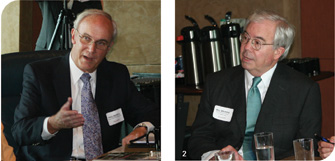
1. Paul Russell talked about the complications of managing health-care negotiations for the sheet-metal workers trust. | 2. Bill Bruning said the public is taking less responsibility for its collective health, and for the health of children, too.
Network and Benefit Design
David Gentile wondered what effect the introduction of accountability into the marketplace would have on network and benefit design. This is a conversation heard often at Inland Truck Parts. “It’s better for our employees to be healthier,” said Greg Klein, “but how do you get your employees to say, ‘I’m going to be healthier?’ How do they engage in making their claims go down?”
Complicating the issue is that Inland has 26 locations across the country and a heavily blue-collar work force. “Our folks don’t want people telling them what to do,” said Klein. “They don’t want people getting into their life.”
Paul Russell, president of Cates Sheet Metal, said the sheet-metal workers trust he also represents provider members incentives to change behavior, but “there’s nothing that says to [the employees] you have got to do this.”
“I like the carrot method,” said Klein, “but the thing that that concerns me with health-care reform is that it seems like it’s more of a stick with the mandates.” He fears that an attempt to control costs—one that pushes people into the system and cuts provider costs—will end with rationing. “This method won’t work if you don’t have the incentive to be more healthy.”
As Rick Kahle noted, it is now possible to “incent” an individual’s behavior, within guidelines, up to $80 a month and that would move up another 10 percent. “Ideally, we will all create a culture of health and productivity and people will do it because it’s the right thing to do,” Kahle added, “but the almighty dollar continues to drive action.”
“I would be in favor of anything that involves freedom of choice,” said Klein. “What I’m opposed to is this mandate, where you’ve got it forced on you.”
On a related note, Rick Kahle asked Paul Russell about his organization’s tolerance for a broad network environment. This is a complicated issue, Russell said, for an organization administered as a self-funded trust. Management sits on one side of a negotiation and the union on the other, with Lockton in an intermediary position and Blue Cross managing its network.
Lest the program seem like an entitlement, Russell said, the trustees have been quizzing employees about their needs, monitoring costs closely, watching the progress of health care reform, and cutting costs where possible through innovations like generic drugs. “The health care issue is almost like a collective-bargaining agreement in union negotiations,” said Russell.
In the way of summary, Bill Bruning, the veteran CEO of the Mid-America Coalition on Healthcare, observed that employers understand that there is significant benefit in having healthier employees. “The [employers] don’t always know how to get there,” said Bruning, “but they have begun to figure out how to shift the dialogue.”
What hasn’t been talked about, Bruning continued, is that the American public is taking less and less responsibility for its own and its children’s health. “There are school districts that can’t use the word ‘obesity’ in talking about children’s health problems,” he noted. That much said, Bruning believes that reform, whether through carrots or sticks, will force people to take responsibility for their risky choices. “In that regard,” he concluded, “I think the dialogue has been very helpful.”
Technology
David Gentile wondered whether emerging technologies like electronic interfacing would ease the pending transitions in care management.
Carolyn Watley has been hoping to get the Greater Kansas City Chamber of Commerce involved in this conversation. Ideally, the chamber would make the health of the community one of its “five big ideas” initiative, and this would help provide incentives for technological reform and coordination.
Kevin Sparks, Blue Cross and Blue Shield’s group executive for internal operations, pulled out his own smart phone and spoke to its potential for putting individual responsibility back into the health-care equation.
“We talk about how we move information around,” he said. “Great. But where’s the individual in that value chain? And how are they continuing to stay accountable in the movement of that information around the system?”
Cost Equation
“How can we get our arms around the cost standpoint a little bit,” asked Rick Kahle, “and still have a terrific benefit offering to our participants that gives us a road map to success?”
“I think healthcare reform cannot occur without payment reform,” said Bruce Bagley. “The payment system must foster shared accountability for both cost and quality. Right now, it does not do that.”
Keith Wisdom believes that to control costs in the long run, the individual mandate has to work. For unit costs to go down, Wisdom argued, uncompensated care has to come to an end. “You have to have everybody in the system for that theory to work.”